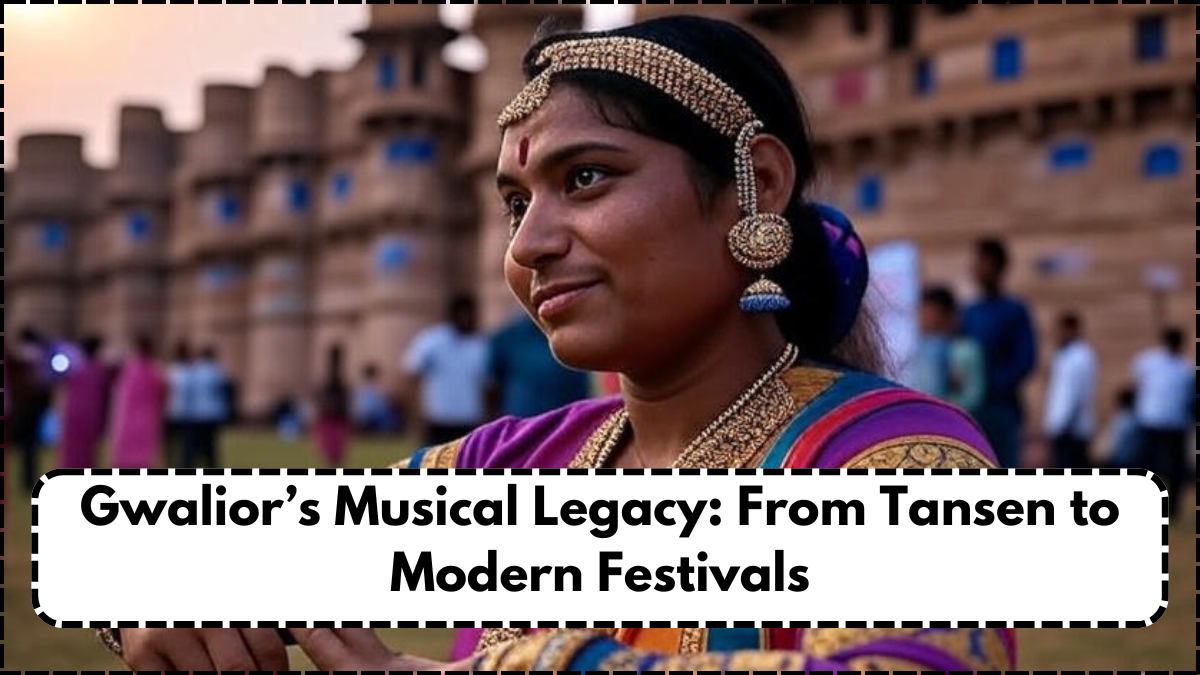The Gwalior music legacy stands as one of the most influential traditions in the history of Indian performing arts. Known as the birthplace of Hindustani classical music’s oldest gharana, Gwalior has produced musicians, composers, and cultural leaders whose impact resonates across centuries. From the legendary Tansen, a jewel of Emperor Akbar’s court, to contemporary music festivals celebrating this heritage, Gwalior remains a vibrant hub of creativity.
At the heart of this story is not only the endurance of tradition but also its evolution. While the foundations of Indian classical music were laid centuries ago, Gwalior has ensured that its musical heritage adapts with the times. Today, the city continues to nurture talent and celebrate its unmatched contribution to India’s cultural identity.

The Roots of Gwalior’s Music Tradition
The Gwalior music legacy traces its roots back to the 15th and 16th centuries. Raja Mansingh Tomar, the ruler of Gwalior, is credited with building a court culture that valued music as much as governance. His patronage created an environment where classical styles flourished. Later, the arrival of Tansen elevated Gwalior’s reputation to new heights.
Tansen’s innovations in ragas and compositions shaped the foundations of Indian classical music as it is practiced today. His emphasis on dhrupad, devotional singing, and melodic purity became defining features of the Gwalior gharana. The gharana’s hallmark lies in its clarity of notes, disciplined rhythm, and structured presentation.
Influence on Indian Classical Music
The Gwalior music legacy played a pivotal role in shaping the broader tradition of Indian classical music. Many gharanas, or schools of music, trace their lineage and inspiration back to Gwalior. Musicians trained in this style were instrumental in carrying classical music beyond courts and temples into wider cultural life.
Key contributions of Gwalior to Indian classical traditions include:
- Standardization of ragas and their structured performance.
- Establishment of dhrupad and khayal as central forms of Hindustani music.
- Creation of a teacher-disciple tradition that continues across generations.
- Influence on other gharanas such as Agra and Jaipur-Atrauli.
This demonstrates how the Gwalior music legacy not only preserved tradition but also spread it across India, ensuring its survival and relevance.
Modern Celebrations and Festivals
Gwalior today honors its heritage through cultural events that attract audiences from across the country. The annual Tansen Music Festival is one of the most prominent platforms where classical maestros perform in tribute to the legendary singer. These festivals serve as living reminders of how deeply the city’s identity is tied to Indian classical music.
Here’s a glimpse of Gwalior’s contribution to modern cultural life:
| Event/Festival | Focus Area | Contribution to Gwalior music legacy |
|---|---|---|
| Tansen Music Festival | Classical music performances | Honors Tansen and keeps traditions alive |
| Sarod Ghar Museum | Display of instruments and recordings | Educates public on musical heritage |
| Local Gharana Gatherings | Community-based performances | Nurtures upcoming talent |
Through these cultural initiatives, the Gwalior music legacy remains a living, breathing part of India’s artistic life rather than a relic of the past.
Gwalior’s Role in Preserving Tradition
In a world where popular and digital music dominates, Gwalior has continued to safeguard classical traditions. Institutions such as music schools and heritage centers are dedicated to passing down knowledge. Younger artists, inspired by maestros, are bringing fresh interpretations without compromising authenticity.
This balance between preservation and innovation highlights the resilience of the Gwalior music legacy. As global interest in Indian classical music grows, Gwalior is positioned as both a custodian of the past and a beacon for the future.
Conclusion
The Gwalior music legacy is not just about the glory of Tansen or the prestige of historic courts—it is about an enduring cultural identity that continues to thrive. By influencing the evolution of Indian classical music, Gwalior has secured its place as one of the most important cultural centers in India. Modern festivals, institutions, and artists keep this tradition relevant, ensuring that Gwalior’s contributions echo far beyond its borders.
FAQs
What makes the Gwalior music legacy unique?
It is the oldest gharana of Hindustani classical music, emphasizing clarity, rhythm, and structure, while shaping other traditions.
How did Tansen influence Indian classical music?
Tansen introduced innovations in ragas and devotional singing, making Gwalior central to the development of Hindustani music.
Why is Gwalior important in Indian classical music history?
Because it standardized forms like dhrupad and khayal, influencing nearly every gharana that followed.
How does Gwalior celebrate its musical heritage today?
Through festivals like the Tansen Music Festival, museums, and community performances that keep traditions alive.
Click here to learn more.
Pari is a passionate writer known for captivating stories that blend imagination and reality. Inspired by travel, history, and everyday moments, Pari crafts narratives that resonate deeply with readers.